Multi-Scale Analysis of Agricultural Drought Propagation on the Iberian Peninsula Using Non-Parametric Indices
Abstract
1. Introduction
2. Materials and Methods
2.1. Dataset
- Total Precipitation [m]—This variable represents the total amount of rain and snow that has fallen on the Earth’s surface between the beginning of the forecast time and the end of the forecast step. The units of precipitation are measured in depth in meters, which represents the extent of water that would be spread uniformly over the grid box;
- Soil Moisture []—This variable represents the volume of water in different soil layers defined by the ECMWF Integrated Forecasting System. Specifically, for this study, we considered the first two ERA5-Land layers, which range from 0 to 28 cm in depth. Although the depth required for the most adequate representation of soil moisture content for agricultural droughts is still under exploration [21,22], we chose to follow the indication of [23], which suggests removing the lower layers to better represent the soil moisture conditions due to ancillary sources such as local rainfall or irrigation, so only the first two ERA5-Land layers were used (0–28 cm);
- Potential Evapotranspiration [m]—This variable is usually considered to be the amount of evaporation, under existing atmospheric conditions, from a surface of water having the temperature of the lowest layer of the atmosphere. The ECMWF Integrated Forecasting System computes it for an agricultural surface assuming it is well-irrigated, presuming that it does not significantly impact the atmospheric conditions in the region, such as humidity or cloud formation. This simplification allows for a standardized approach to estimating potential evaporation in agricultural contexts, which can introduce some uncertainties. In this respect, we compared the potential evapotranspiration derived from ERA5-Land with that calculated using the Penman-Monteith [24] equation, which takes into account various meteorological variables and thus eliminates the assumption of zero atmospheric impact, and we found that there were no significant differences in the results between the two methods.
2.2. Drought Indices
2.3. Methods of Analysis
- -
- Percentage: spatial fraction of IP affected by severe/extreme droughts;
- -
- Duration: number of months with drought index values below the −1.5 threshold;
- -
- Frequency: number of drought events per year;
- -
- Severity: lowest value of the drought index during the drought periods;
- -
- Intensity: ratio of drought severity to the drought duration;
- -
- Magnitude: sum of absolute values of the drought index during the drought period.
3. Results
3.1. Characterization of Agricultural Drought over the IP
3.2. Propagation from Meteorological to Agricultural Drought
4. Discussion
5. Conclusions
- Results showed a slight trend towards increased dryness over the last two decades and identified multi-variate AD indices as more effective in identifying severe drought events compared to the uni-variate SSI index.
- The severity values of the four AD indices were generally higher than those of SPEI-1 and SPEI-3, indicating that the agricultural drought impacts were more severe and extensive than the meteorological drought.
- This study introduced a novel combined agricultural drought index that balances the characteristics of other adopted indices and could be a valuable resource for future investigations.
- The response time scale was calculated for the AD indices and small values were obtained, also suggesting that the contribution of water balance accelerated the response compared to the effect of soil moisture alone.
- The analysis of the 2005 episode revealed a 2-month delayed onset compared to other AD indices in the analysis of seasonal agricultural drought, with a higher probability of propagation depending on the severity of the originating meteorological drought.
Author Contributions
Funding
Data Availability Statement
Acknowledgments
Conflicts of Interest
References
- Martín-Vide, J.; Barriendos Vallvé, M. The use of rogation ceremony records in climatic reconstruction: A case study from Catalonia (Spain). Clim. Change 1995, 30, 201–221. [Google Scholar] [CrossRef]
- Austin, R.; Cantero-Martınez, C.; Arrúe, J.L.; Playán, E.; Cano-Marcellán, P. Yield-rainfall relationships in cereal cropping systems in the Ebro river valley of Spain. Eur. J. Agron. 1998, 8, 239–248. [Google Scholar] [CrossRef]
- Vicente-Serrano, S.M.; Lopez-Moreno, J.I.; Beguería, S.; Lorenzo-Lacruz, J.; Sánchez-Lorenzo, A.; García-Ruiz, J.; Azorin-Molina, C.; Morán-Tejeda, E.; Revuelto, J.; Trigo, R.; et al. Evidence of increasing drought severity caused by temperature rise in southern Europe. Environ. Res. Lett. 2014, 9, 044001. [Google Scholar] [CrossRef]
- Páscoa, P.; Gouveia, C.M.; Russo, A.; Trigo, R.M. Drought trends in the Iberian Peninsula over the last 112 years. Adv. Meteorol. 2017, 2017, 4653126. [Google Scholar] [CrossRef]
- McKee, T. Drought monitoring with multiple time scales. In Proceedings of the 9th Conference on Applied Climatology, Dallas, TX, USA, 15–20 January 1995. [Google Scholar]
- Zhuang, X.; Hao, Z.; Singh, V.; Zhang, Y.; Feng, S.; Xu, Y.; Hao, F. Drought propagation under global warming: Characteristics, approaches, processes, and controlling factors. Sci. Total Environ. 2022, 838, 156021. [Google Scholar] [CrossRef]
- Xu, Y.; Wang, L.; Ross, K.; Liu, C.; Berry, K. Standardized soil moisture index for drought monitoring based on soil moisture active passive observations and 36 years of north American land data assimilation system data: A case study in the southeast United States. Remote Sens. 2018, 10, 301. [Google Scholar] [CrossRef]
- Zhou, K.; Li, J.; Zhang, T.; Kang, A. The use of combined soil moisture data to characterize agricultural drought conditions and the relationship among different drought types in China. Agric. Water Manag. 2021, 243, 106479. [Google Scholar] [CrossRef]
- Bae, H.; Ji, H.; Lim, Y.-J.; Ryu, Y.; Kim, M.-H.; Kim, B.-J. Characteristics of drought propagation in South Korea: Relationship between meteorological, agricultural, and hydrological droughts. Nat. Hazards 2019, 99, 1–16. [Google Scholar] [CrossRef]
- Vicente-Serrano, S.; Beguería, S.; López-Moreno, J. A multiscalar drought index sensitive to global warming: The standardized precipitation evapotranspiration index. J. Clim. 2010, 23, 1696–1718. [Google Scholar] [CrossRef]
- Li, Y.; Huang, S.; Wang, H.; Zheng, X.; Huang, Q.; Deng, M.; Peng, J. High-resolution propagation time from meteorological to agricultural drought at multiple levels and spatiotemporal scales. Agric. Water Manag. 2022, 262, 107428. [Google Scholar] [CrossRef]
- Quiring, S.; Ford, T.; Wang, J.; Khong, A.; Harris, E.; Lindgren, T.; Goldberg, D.; Li, Z. The North American soil moisture database: Development and applications. Bull. Am. Meteorol. Soc. 2016, 97, 1441–1459. [Google Scholar] [CrossRef]
- Zhu, Y.; Liu, Y.; Wang, W.; Singh, V.; Ren, L. A global perspective on the probability of propagation of drought: From meteorological to soil moisture. J. Hydrol. 2021, 603, 126907. [Google Scholar] [CrossRef]
- Tian, Q.; Lu, J.; Chen, X. A novel comprehensive agricultural drought index reflecting time lag of soil moisture to meteorology: A case study in the Yangtze River basin, China. Catena 2022, 209, 105804. [Google Scholar] [CrossRef]
- Xia, Y.; Sheffield, J.; Ek, M.; Dong, J.; Chaney, N.; Wei, H.; Meng, J.; Wood, E. Evaluation of multi-model simulated soil moisture in NLDAS-2. J. Hydrol. 2014, 512, 107–125. [Google Scholar] [CrossRef]
- Muñoz Sabater, J. ERA5-Land Monthly Averaged Data from 1981 to Present, Copernicus Climate Change Service (C3S) Climate Data Store (CDS). 2019. Available online: https://doi.org/10.24381/cds.68d2bb30 (accessed on 4 November 2022).
- Zhang, R.; Li, L.; Zhang, Y.; Huang, F.; Li, J.; Liu, W.; Mao, T.; Xiong, Z.; Shangguan, W. Assessment of agricultural drought using soil water deficit index based on ERA5-land soil moisture data in four southern provinces of China. Agriculture 2021, 11, 411. [Google Scholar] [CrossRef]
- Beck, H.E.; Pan, M.; Miralles, D.G.; Reichle, R.H.; Dorigo, W.A.; Hahn, S.; Sheffield, J.; Karthikeyan, L.; Balsamo, G.; Parinussa, R.M.; et al. Evaluation of 18 satellite-and model-based soil moisture products using in situ measurements from 826 sensors. Hydrol. Earth Syst. Sci. 2021, 25, 17–40. [Google Scholar] [CrossRef]
- Almendra-Martín, L.; Martínez-Fernández, J.; González-Zamora, Á.; Benito-Verdugo, P.; Herrero-Jiménez, C.M. Agricultural drought trends on the Iberian Peninsula: An analysis using modeled and reanalysis soil moisture products. Atmosphere 2021, 12, 236. [Google Scholar] [CrossRef]
- Muñoz-Sabater, J.; Dutra, E.; Agustí-Panareda, A.; Albergel, C.; Arduini, G.; Balsamo, G.; Boussetta, S.; Choulga, M.; Harrigan, S.; Hersbach, H.; et al. ERA5-Land: A state-of-the-art global reanalysis dataset for land applications. Earth Syst. Sci. Data 2021, 13, 4349–4383. [Google Scholar] [CrossRef]
- Arora, V.; Boer, G. A representation of variable root distribution in dynamic vegetation models. Earth Interact. 2003, 7, 1–19. [Google Scholar] [CrossRef]
- Qiu, J.; Crow, W.; Nearing, G. The impact of vertical measurement depth on the information content of soil moisture for latent heat flux estimation. J. Hydrometeorol. 2016, 17, 2419–2430. [Google Scholar] [CrossRef]
- Bageshree, K.; Kinouchi, T. A Multivariate Drought Index for Seasonal Agriculture Drought Classification in Semiarid Regions. Remote Sens. 2022, 14, 3891. [Google Scholar] [CrossRef]
- Monteith, J. Evaporation and environment. In Proceedings of the Symposia of the Society for Experimental Biology; Cambridge University Press (CUP): Cambridge, UK, 1965; Volume 19, pp. 205–234. [Google Scholar]
- Hao, Z.; AghaKouchak, A. A nonparametric multivariate multi-index drought monitoring framework. J. Hydrometeorol. 2014, 15, 89–101. [Google Scholar] [CrossRef]
- Khan, M.I.; Zhu, X.; Arshad, M.; Zaman, M.; Niaz, Y.; Ullah, I.; Anjum, M.N.; Uzair, M. Assessment of spatiotemporal characteristics of agro-meteorological drought events based on comparing Standardized Soil Moisture Index, Standardized Precipitation Index and Multivariate Standardized Drought Index. J. Water Clim. Change 2020, 11, 1–17. [Google Scholar] [CrossRef]
- Hao, Z.; AghaKouchak, A. Multivariate standardized drought index: A parametric multi-index model. Adv. Water Resour. 2013, 57, 12–18. [Google Scholar] [CrossRef]
- Xu, L.; Chen, N.; Yang, C.; Zhang, C.; Yu, H. A parametric multivariate drought index for drought monitoring and assessment under climate change. Agric. For. Meteorol. 2021, 310, 108657. [Google Scholar] [CrossRef]
- Gringorten, I. A plotting rule for extreme probability paper. J. Geophys. Res. 1963, 68, 813–814. [Google Scholar] [CrossRef]
- García-Valdecasas Ojeda, M.; Gámiz-Fortis, S.; Romero-Jiménez, E.; Rosa-Cánovas, J.; Yeste, P.; Castro-Díez, Y.; Esteban-Parra, M. Projected changes in the Iberian Peninsula drought characteristics. Sci. Total Environ. 2021, 757, 143702. [Google Scholar] [CrossRef]
- Spinoni, J.; Vogt, J.; Naumann, G.; Barbosa, P.; Dosio, A. Will drought events become more frequent and severe in Europe? Int. J. Climatol. 2018, 38, 1718–1736. [Google Scholar] [CrossRef]
- Spinoni, J.; Naumann, G.; Vogt, J.; Barbosa, P. Meteorological Droughts in Europe: Events and Impacts-Past Trends and Future Projections; Publications Office of the European Union: Brussels, Belgium, 2016.
- Myneni, R.; Williams, D. On the relationship between FAPAR and NDVI. Remote Sens. Environ. 1994, 49, 200–211. [Google Scholar] [CrossRef]
- Gobron, N.; Pinty, B.; Mélin, F.; Taberner, M.; Verstraete, M.; Belward, A.; Lavergne, T.; Widlowski, J.-L. The state of vegetation in Europe following the 2003 drought. Int. J. Remote Sens. 2005, 26, 2013–2020. [Google Scholar] [CrossRef]
- Spinoni, J.; Muñoz, C.; Masante, D.; McCormick, N.; Vogt, J.; Barbosa, P. European Drought Observatory; European Commission: Ispra, Italy, 2018.
- Peng, J.; Muller, J.-P.; Blessing, S.; Giering, R.; Danne, O.; Gobron, N.; Kharbouche, S.; Ludwig, R.; Müller, B.; Leng, G.; et al. Can we use satellite-based FAPAR to detect drought? Sensors 2019, 19, 3662. [Google Scholar] [CrossRef]
- Zhang, Q.; Li, Q.; Singh, V.; Shi, P.; Huang, Q.; Sun, P. Nonparametric integrated agrometeorological drought monitoring: Model development and application. J. Geophys. Res. Atmos. 2018, 123, 73–88. [Google Scholar] [CrossRef]
- Yevjevich, V. Objective Approach to Definitions and Investigations of Continental Hydrologic Droughts. Ph.D. Thesis, Colorado State University, Fort Collins, CO, USA, 1967. [Google Scholar]
- Huang, S.; Huang, Q.; Chang, J.; Leng, G.; Xing, L. The response of agricultural drought to meteorological drought and the influencing factors: A case study in the Wei River Basin, China. Agric. Water Manag. 2015, 159, 45–54. [Google Scholar] [CrossRef]
- Ivanova, M. Assessing the United Nations Environment Programme. Glob. Commons 2006, 2, 117–158. [Google Scholar]
- Sapir, D.; Misson, C. The development of a database on disasters. Disasters 1992, 16, 74–80. [Google Scholar] [CrossRef]
- Tijdeman, E.; Blauhut, V.; Stoelzle, M.; Menzel, L.; Stahl, K. Different drought types and the spatial variability in their hazard, impact, and propagation characteristics. Nat. Hazards Earth Syst. Sci. 2022, 22, 2099–2116. [Google Scholar] [CrossRef]
- Sattar, M.; Lee, J.-Y.; Shin, J.-Y.; Kim, T.-W. Probabilistic characteristics of drought propagation from meteorological to hydrological drought in South Korea. Water Resour. Manag. 2019, 33, 2439–2452. [Google Scholar] [CrossRef]
- Scaini, A.; Sánchez, N.; Vicente-Serrano, S.; Martínez-Fernández, J. SMOS-derived soil moisture anomalies and drought indices: A comparative analysis using in situ measurements. Hydrol. Process. 2015, 29, 373–383. [Google Scholar] [CrossRef]
- García-Herrera, R.; Hernández, E.; Barriopedro, D.; Paredes, D.; Trigo, R.; Trigo, I.; Mendes, M. The outstanding 2004/05 drought in the Iberian Peninsula: Associated atmospheric circulation. J. Hydrometeorol. 2007, 8, 483–498. [Google Scholar] [CrossRef]
- Coll, J.; Aguilar, E.; Ashcroft, L. Drought variability and change across the Iberian Peninsula. Theor. Appl. Climatol. 2017, 130, 901–916. [Google Scholar] [CrossRef]
- Wong, G.; van Lanen, H.; Torfs, P. Probabilistic analysis of hydrological drought characteristics using meteorological drought. Hydrol. Sci. J. 2013, 58, 253–270. [Google Scholar] [CrossRef]
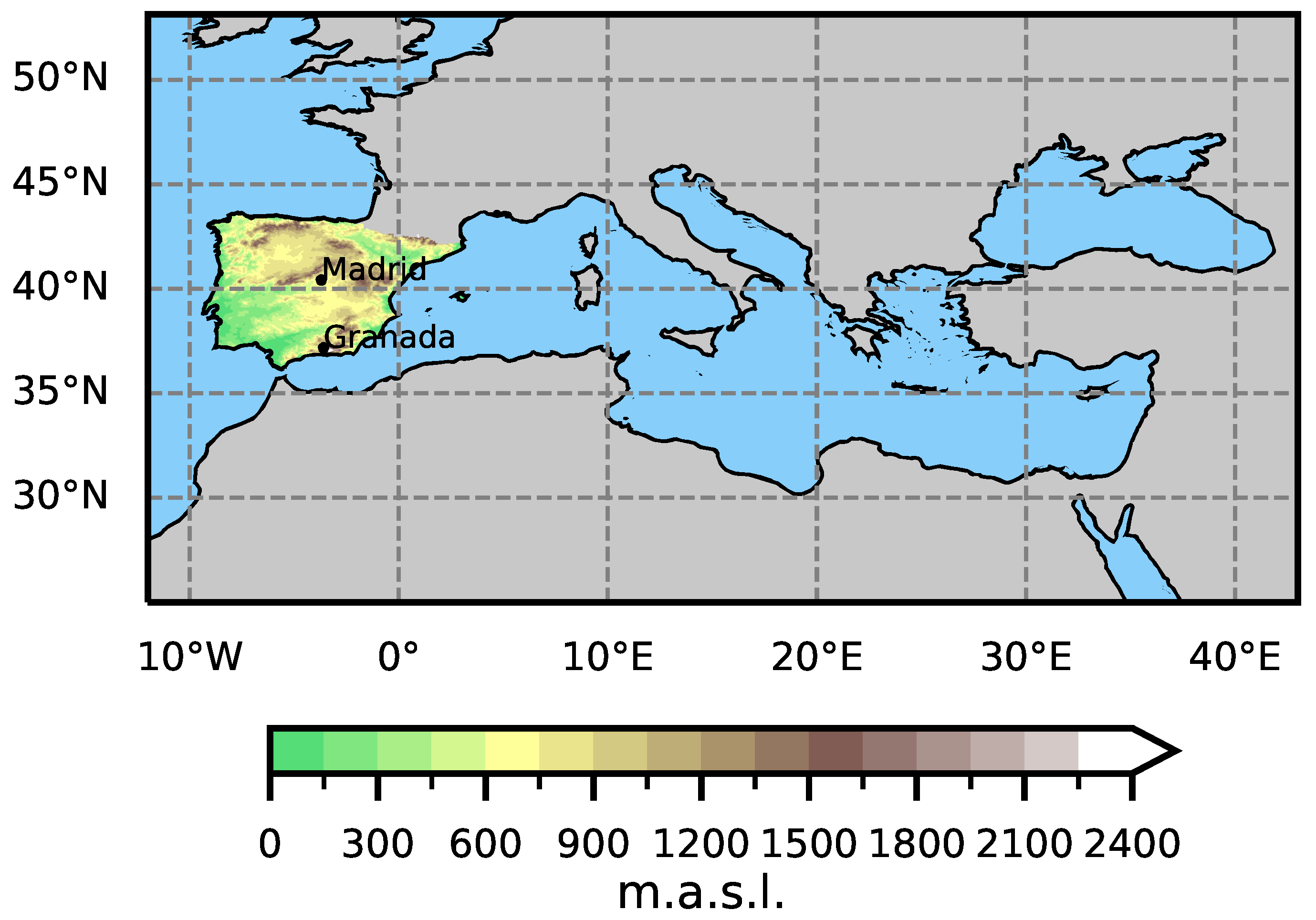
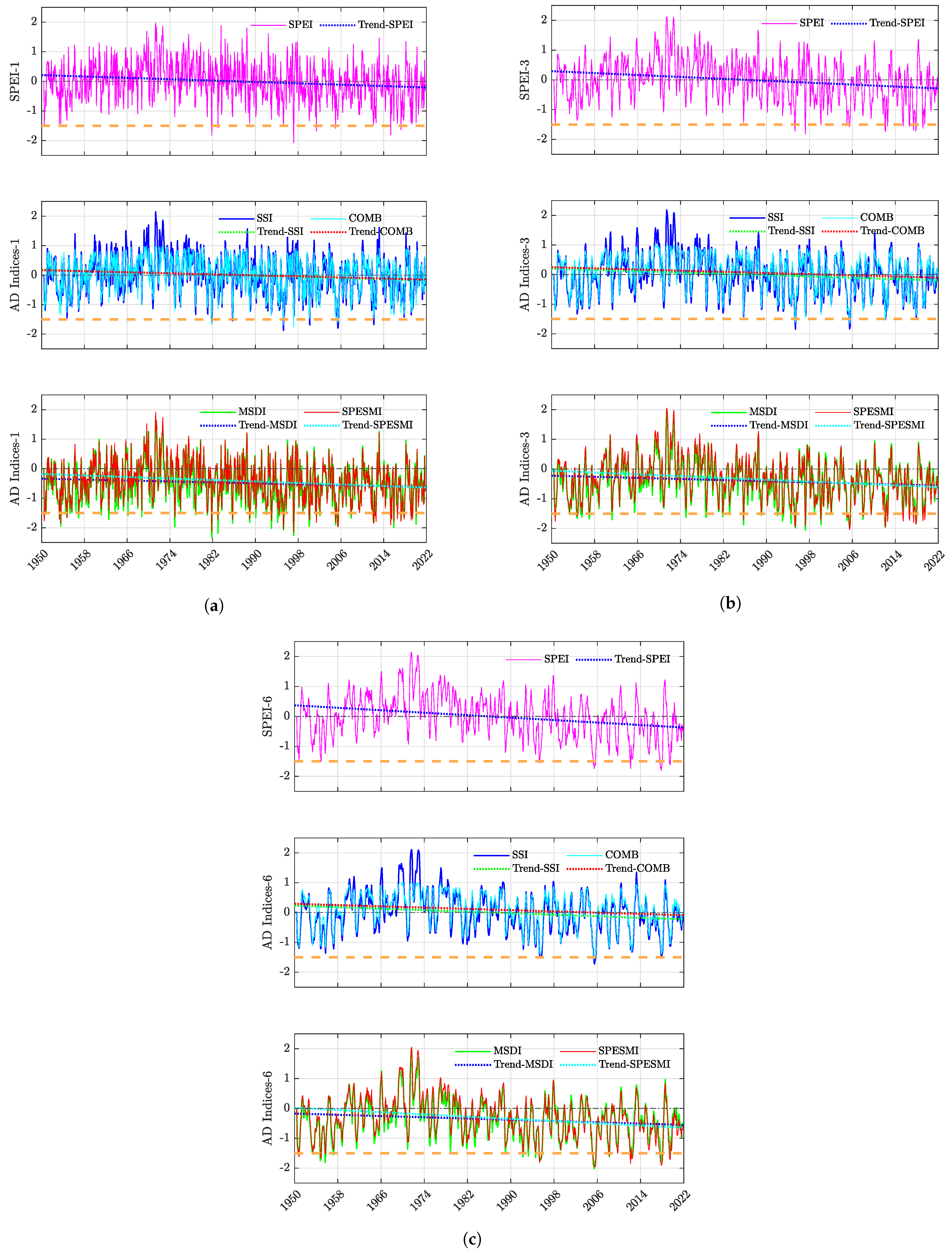
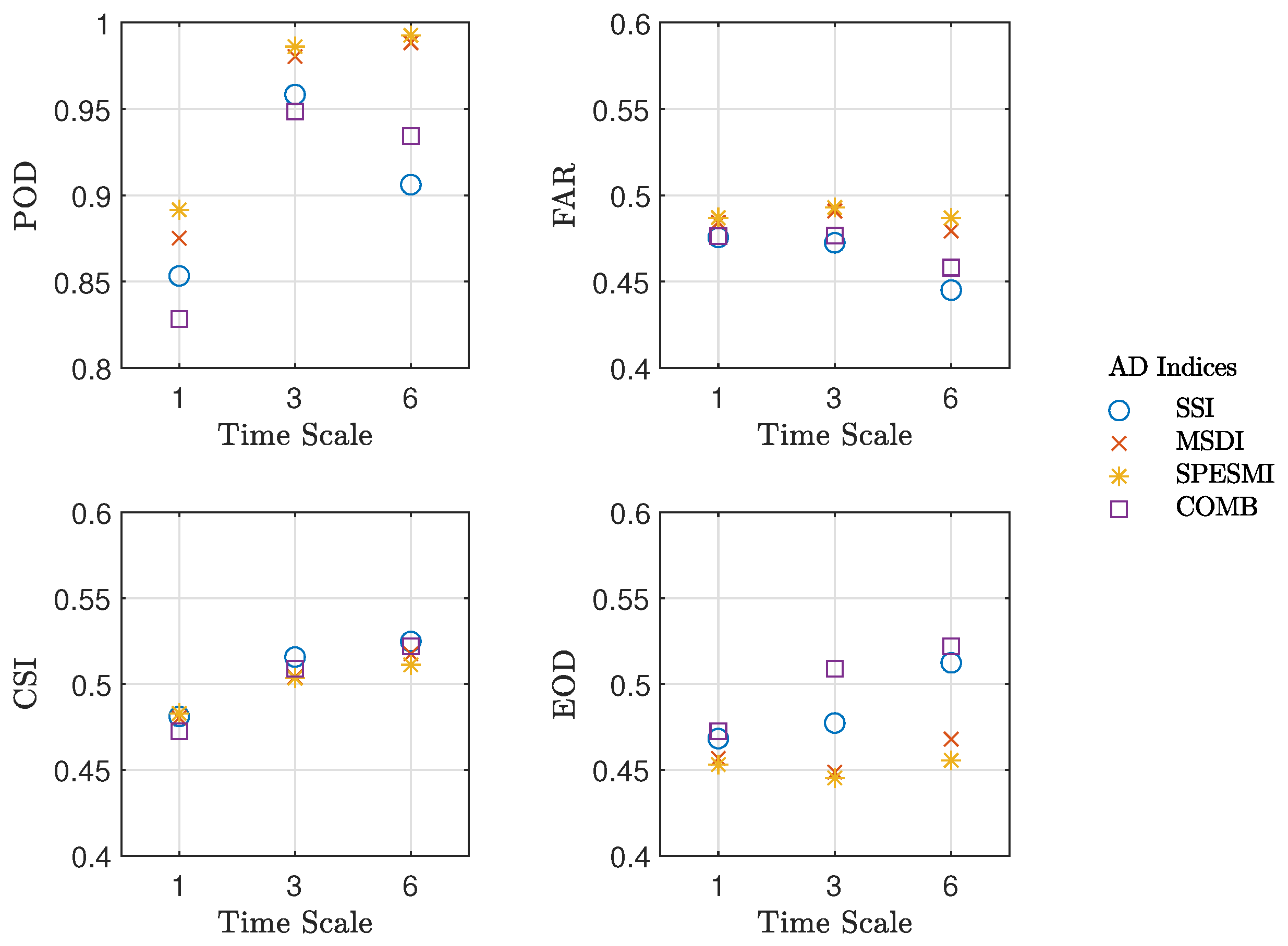
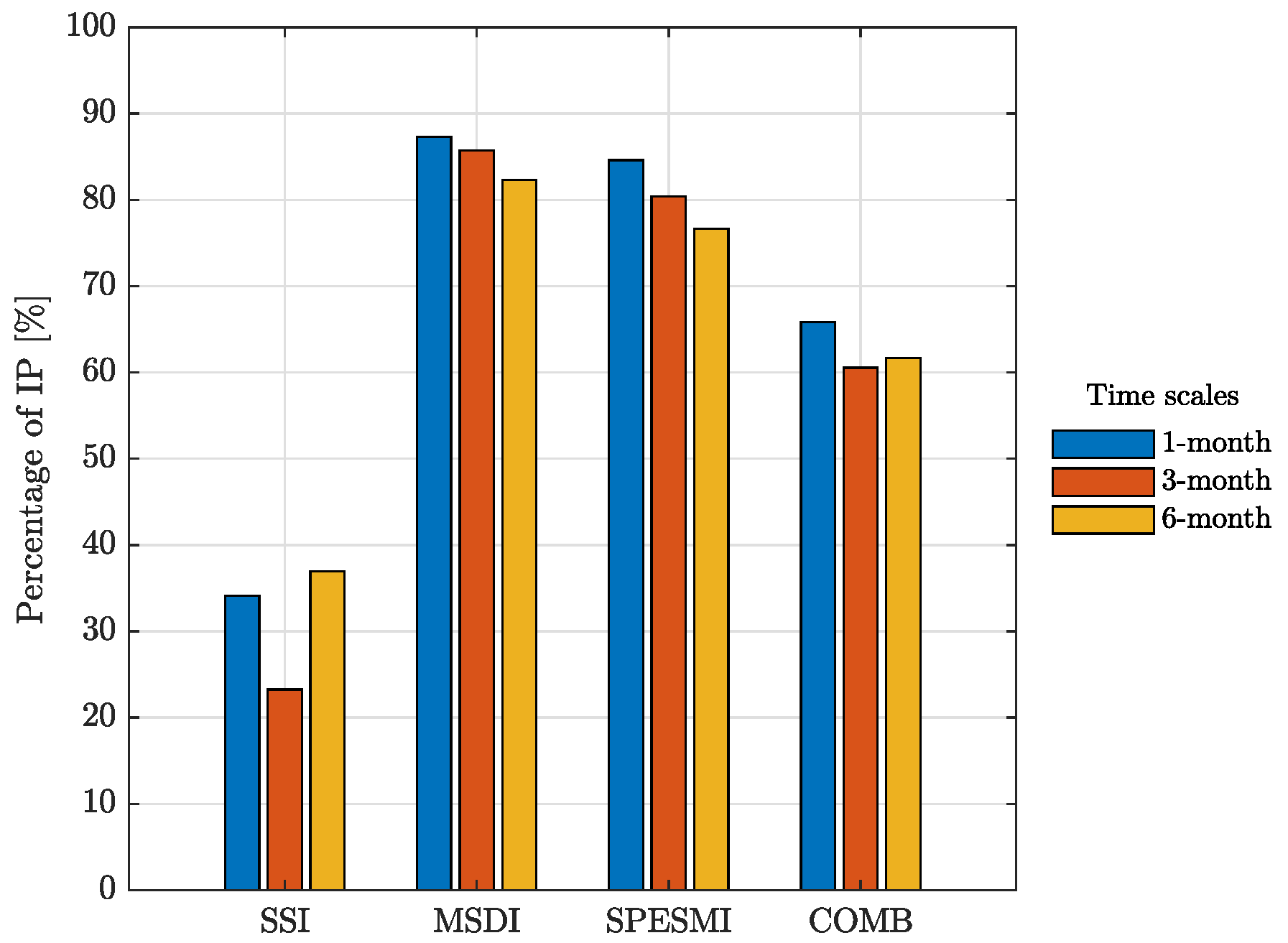
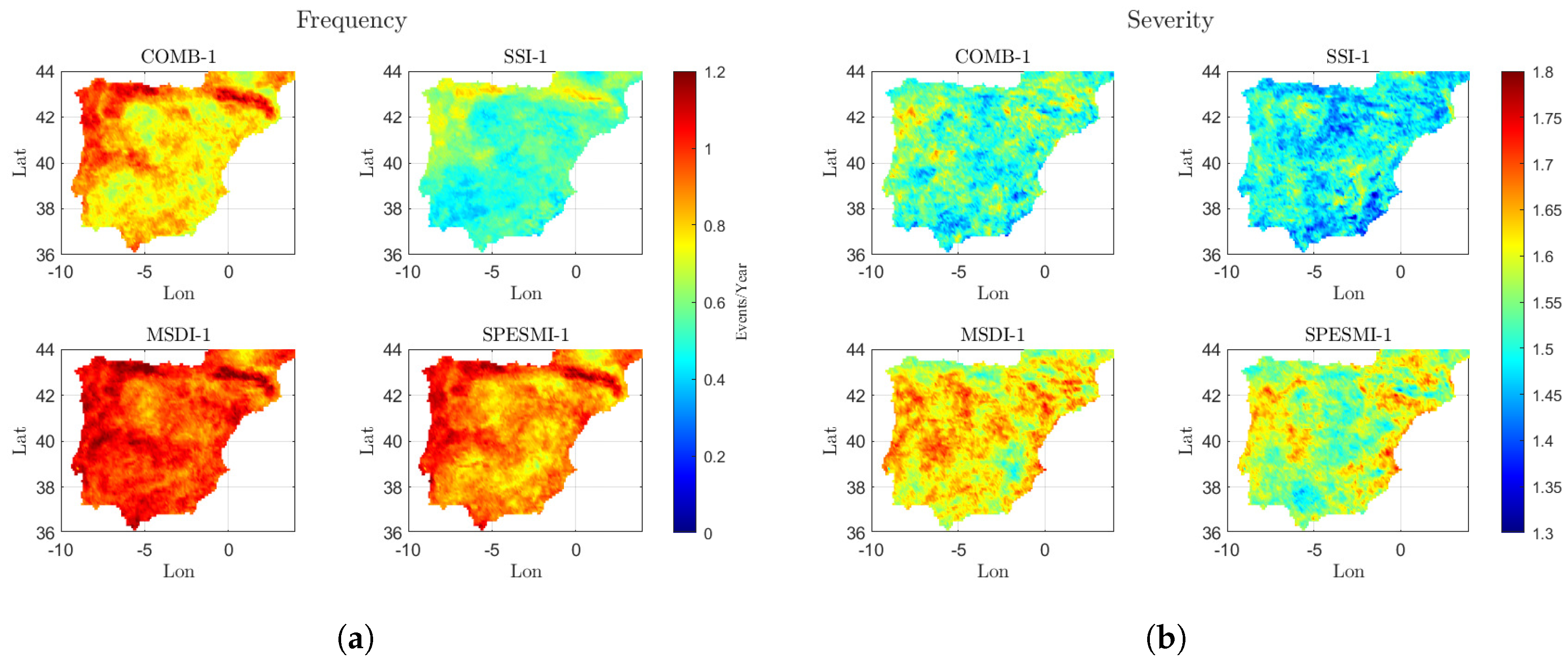
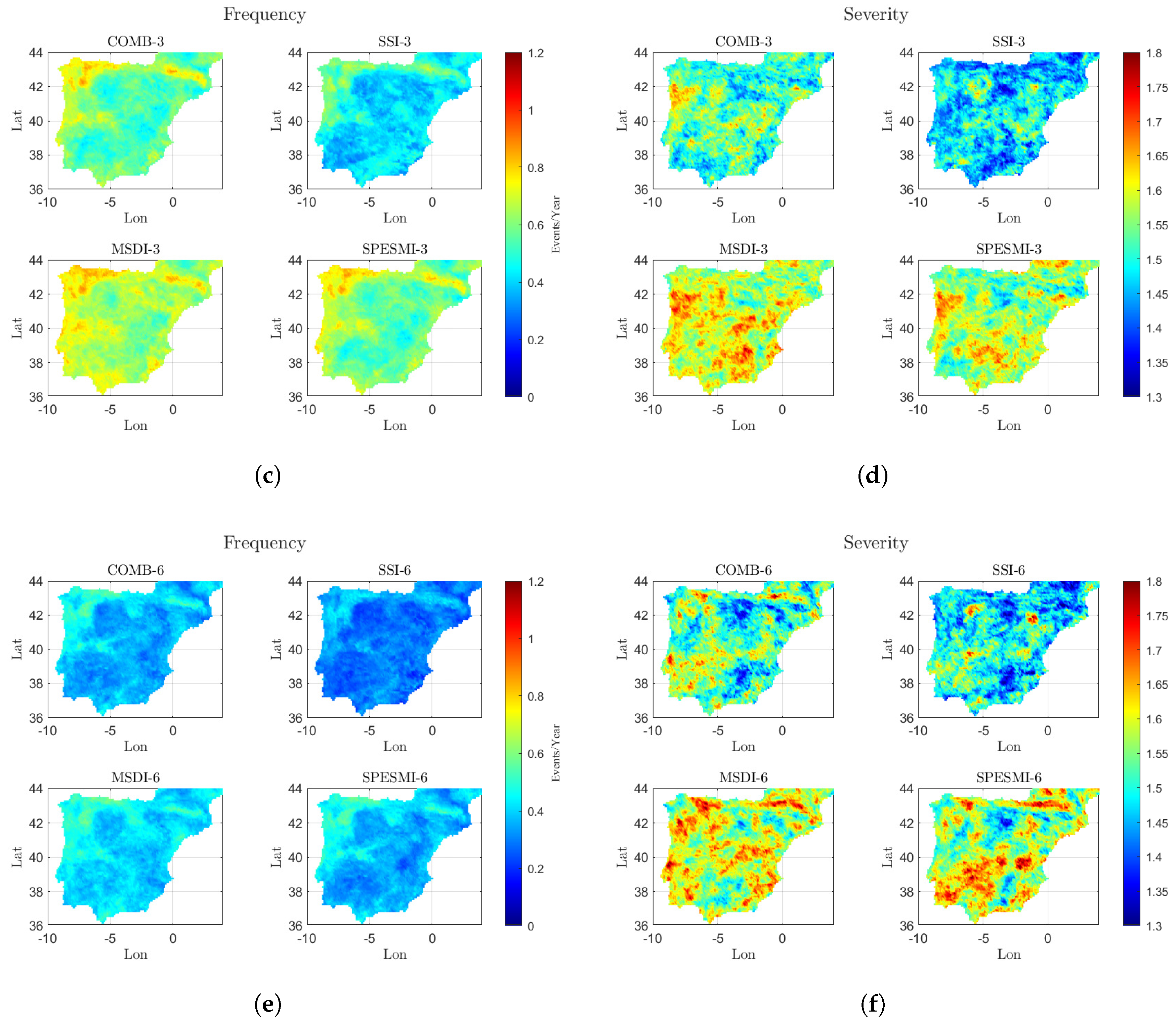
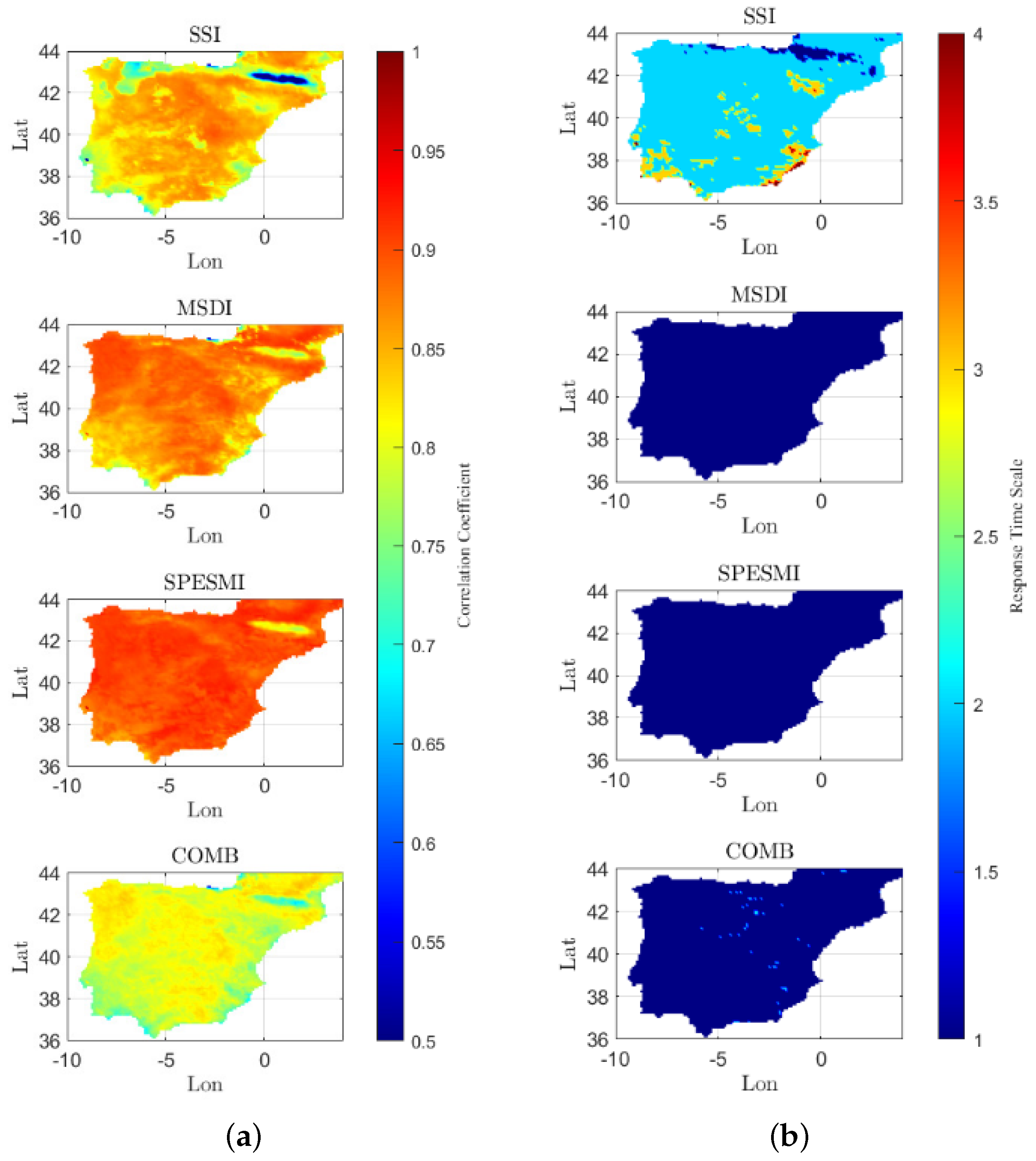
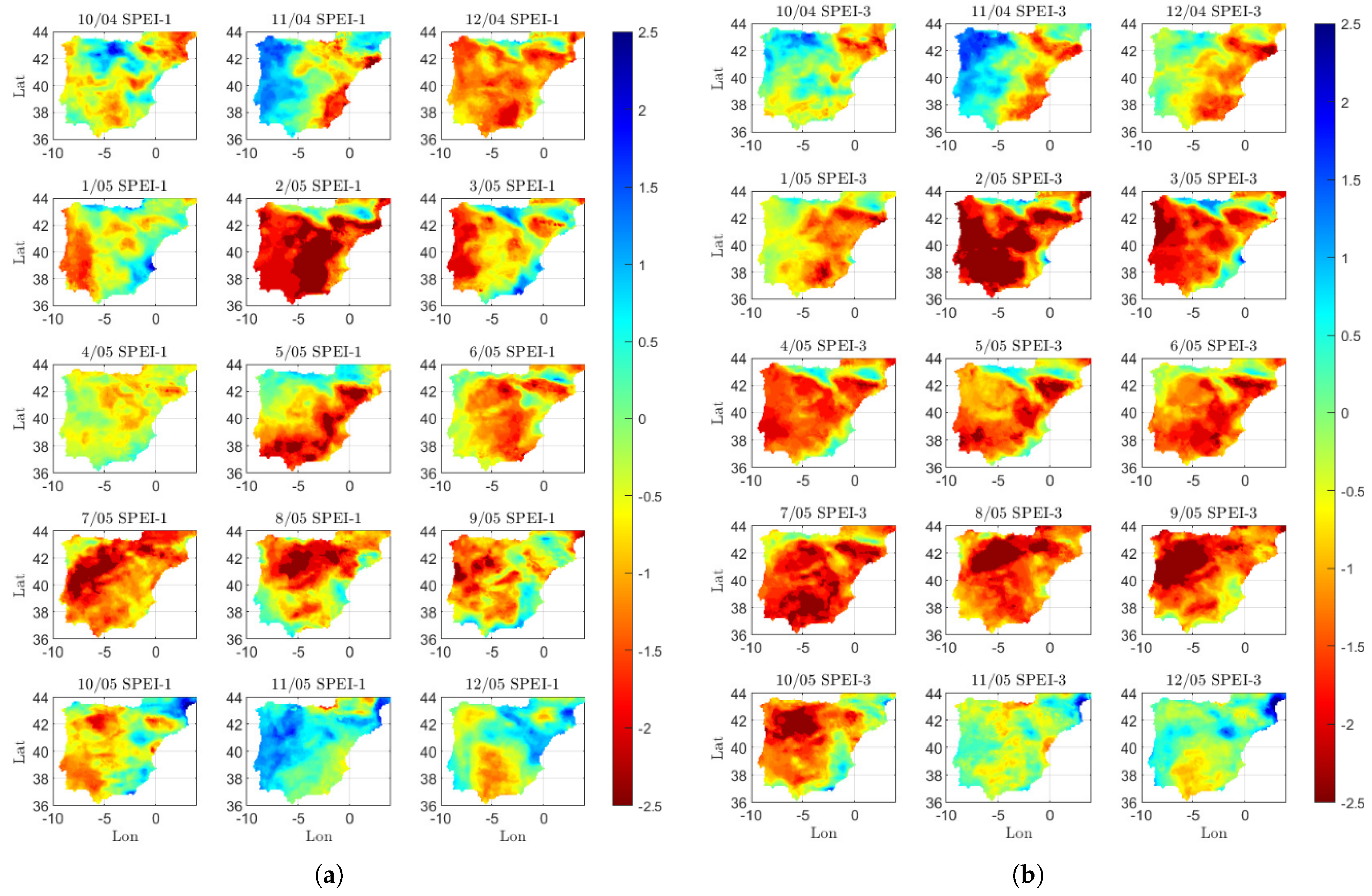
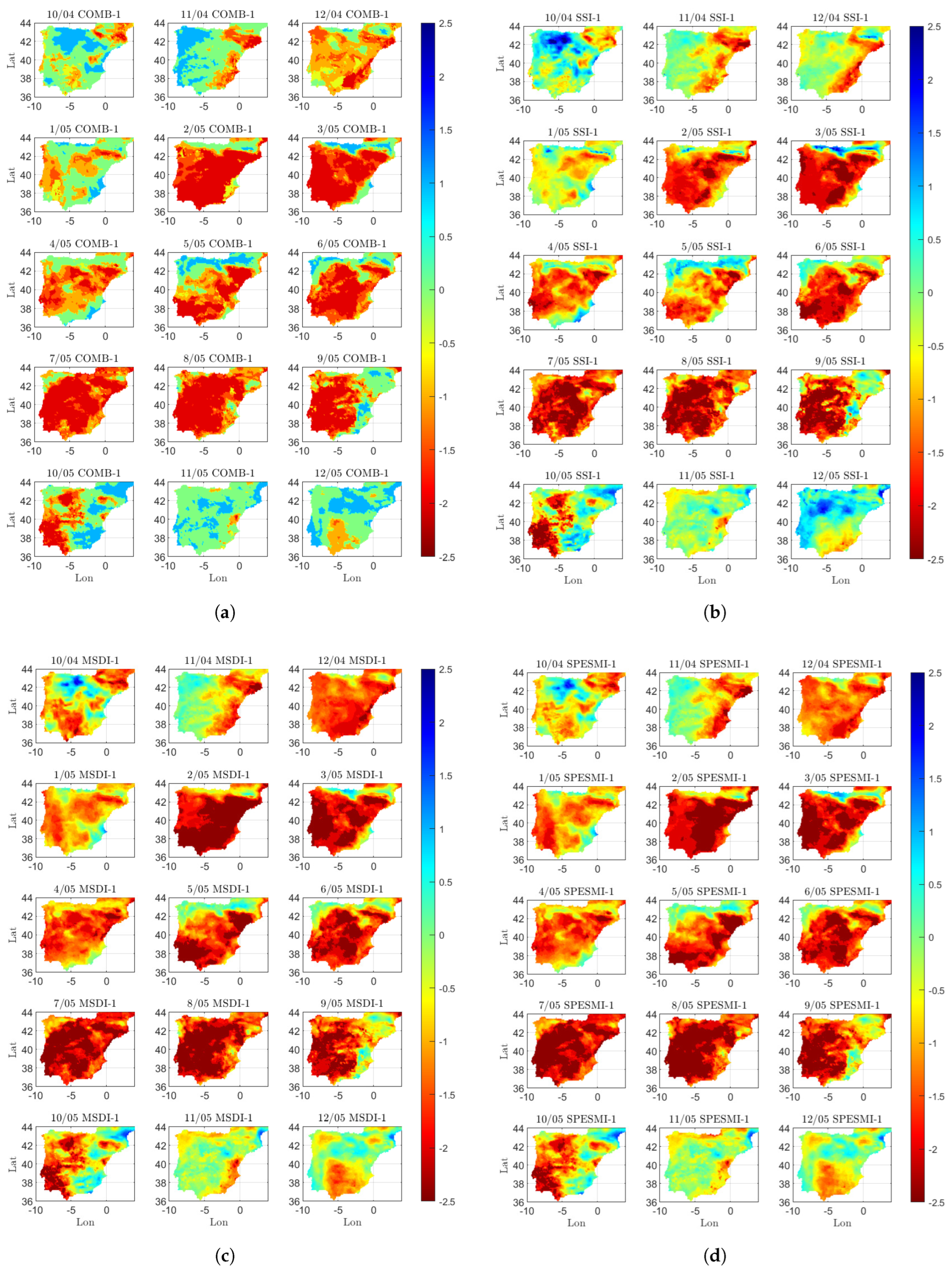
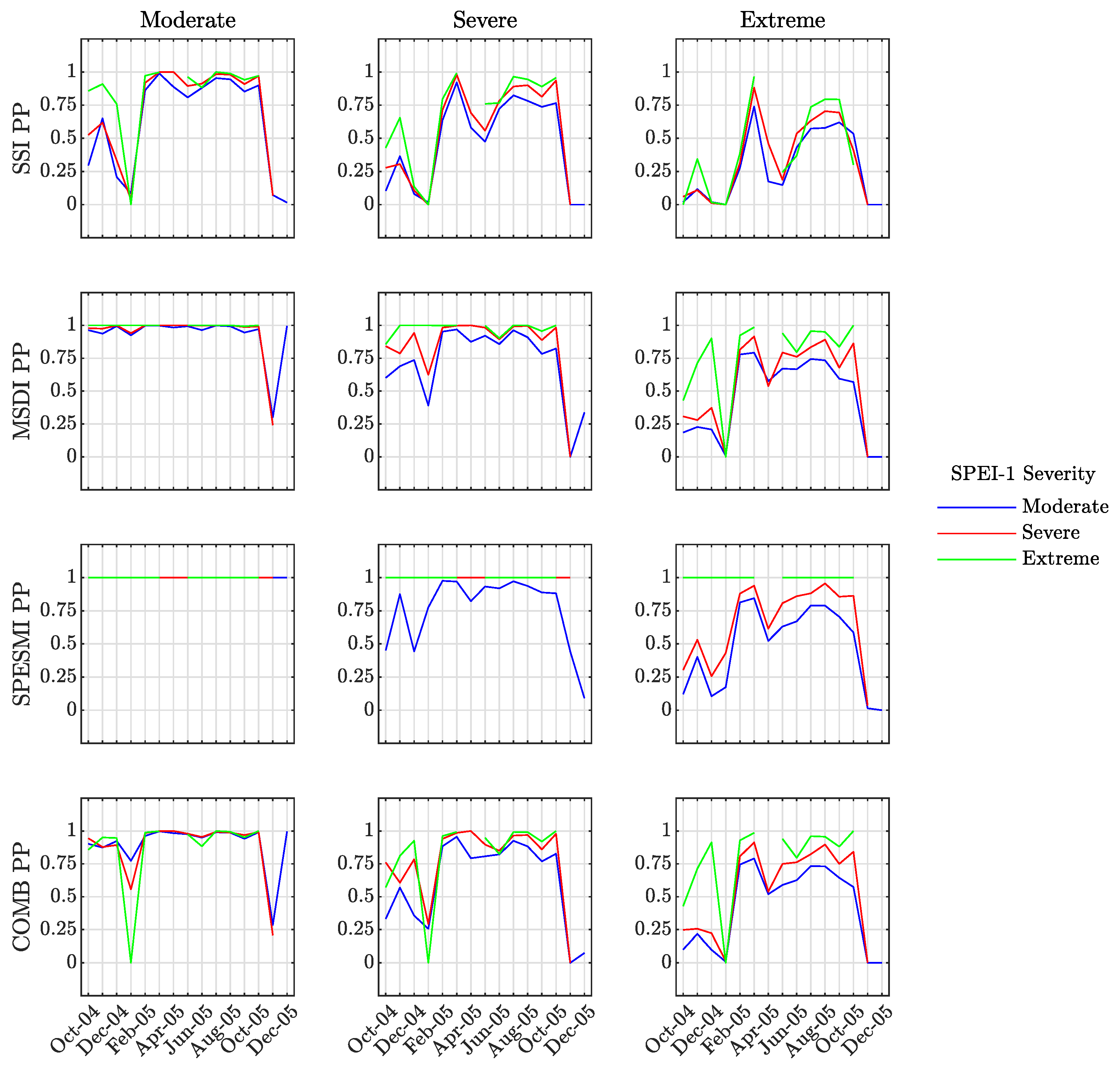
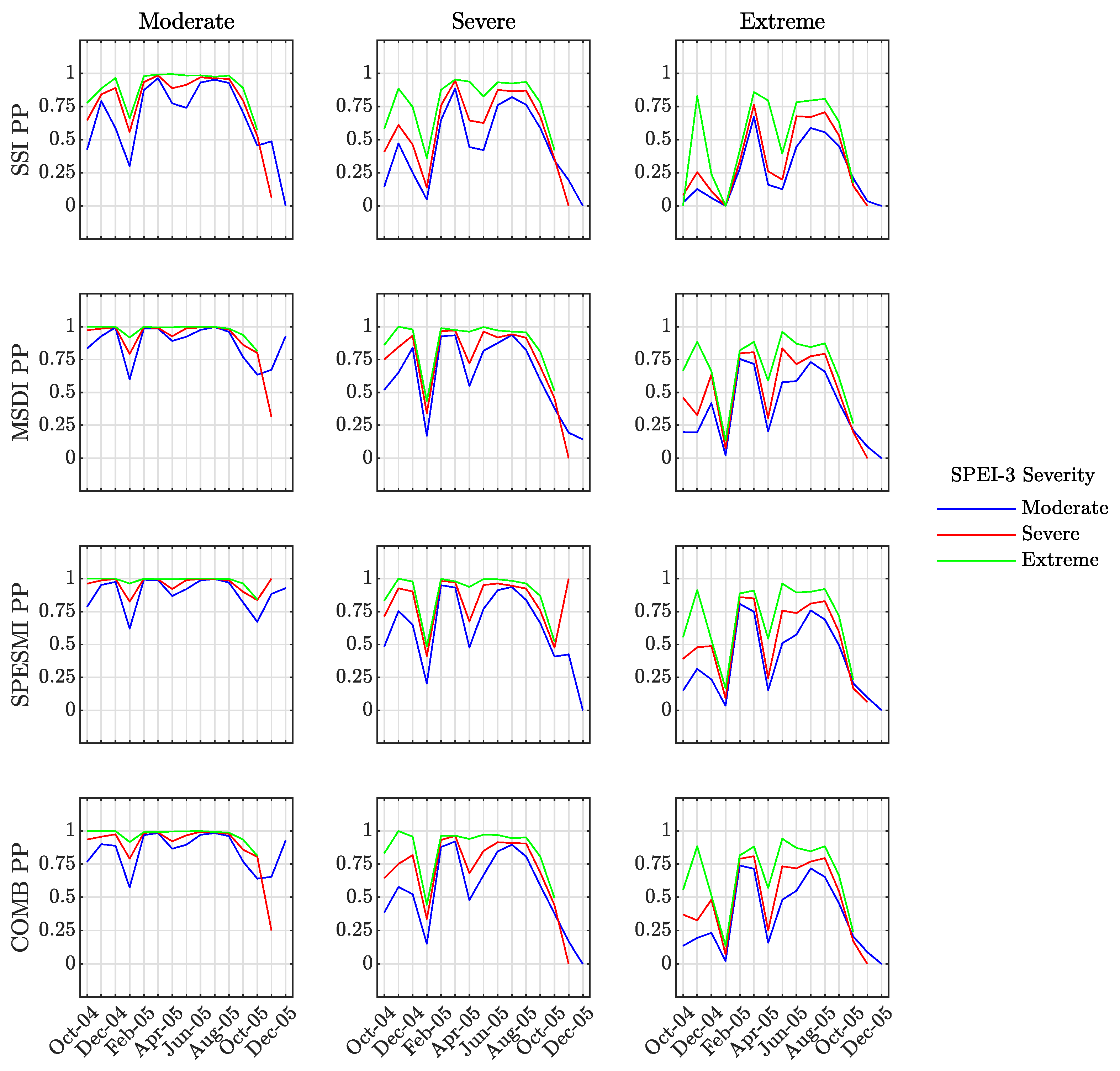
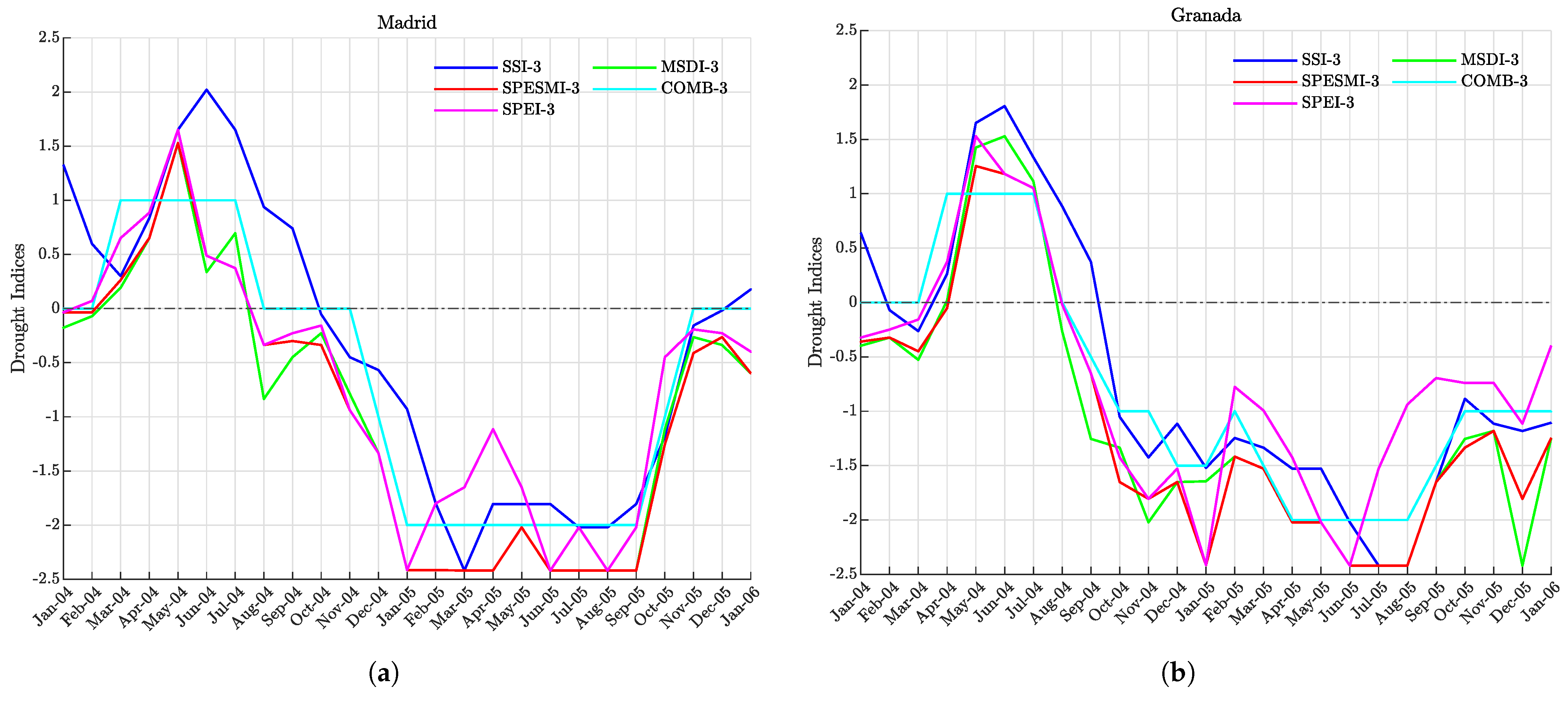
| Drought Index | Structure | Variables | Type of Drought |
|---|---|---|---|
| SPEI | Multivariate | P–E | Meteorological |
| SSI | Univariate | SM | Agricultural |
| MSDI | Multivariate | P, SM | Agro-Meteorological |
| SPESMI | Multivariate | P–E, SM | Agro-Meteorological |
| Drought Index Value | Drought Category | Conditions |
|---|---|---|
| Index | −2 | Extreme Drought |
| Index | −1.5 | Severe Drought |
| Index | −1 | (Moderate) Drought |
| Index | −0.5 | Dry |
| Index | 1 | Normal/wet |
| Drought Indices Values (SSI, MSDI, SPESMI) | COMB | Conditions |
|---|---|---|
| 2 + indices ] | −2 | Extreme Drought |
| 2 + indices ] | −1.5 | Severe Drought |
| 2 + indices ] | −1 | (Moderate) Drought |
| 2 + indices ] | −0.5 | Dry |
| 2 + indices ) | 1 | Normal/wet |
Disclaimer/Publisher’s Note: The statements, opinions and data contained in all publications are solely those of the individual author(s) and contributor(s) and not of MDPI and/or the editor(s). MDPI and/or the editor(s) disclaim responsibility for any injury to people or property resulting from any ideas, methods, instructions or products referred to in the content. |
© 2023 by the authors. Licensee MDPI, Basel, Switzerland. This article is an open access article distributed under the terms and conditions of the Creative Commons Attribution (CC BY) license (https://creativecommons.org/licenses/by/4.0/).
Share and Cite
Possega, M.; García-Valdecasas Ojeda, M.; Gámiz-Fortis, S.R. Multi-Scale Analysis of Agricultural Drought Propagation on the Iberian Peninsula Using Non-Parametric Indices. Water 2023, 15, 2032. https://doi.org/10.3390/w15112032
Possega M, García-Valdecasas Ojeda M, Gámiz-Fortis SR. Multi-Scale Analysis of Agricultural Drought Propagation on the Iberian Peninsula Using Non-Parametric Indices. Water. 2023; 15(11):2032. https://doi.org/10.3390/w15112032
Chicago/Turabian StylePossega, Marco, Matilde García-Valdecasas Ojeda, and Sonia Raquel Gámiz-Fortis. 2023. "Multi-Scale Analysis of Agricultural Drought Propagation on the Iberian Peninsula Using Non-Parametric Indices" Water 15, no. 11: 2032. https://doi.org/10.3390/w15112032
APA StylePossega, M., García-Valdecasas Ojeda, M., & Gámiz-Fortis, S. R. (2023). Multi-Scale Analysis of Agricultural Drought Propagation on the Iberian Peninsula Using Non-Parametric Indices. Water, 15(11), 2032. https://doi.org/10.3390/w15112032






